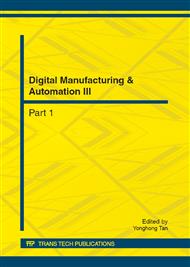p.101
p.106
p.111
p.115
p.121
p.126
p.133
p.139
p.143
Numerical Investigation of Fine Blanking of a Helical Gear
Abstract:
Fine blanking, as an effective and economy metal forming process, can be used for the manufacturing of helical gears with inclined forming movement. In the present study, a reliable three-dimensional (3D) rigid-plastic finite element (FE) model is developed on the DEFORM-3D platform for rotational fine blanking of a helical gear. Based on this FE model, distributions of different field variables such as metal flow velocity, mean stress and effective strain are obtained, and cut surface features and punch stroke curve are predicted. The results achieved in this study can not only evaluate the capabilities of the rotational fine blanking process of a helical gear, but also provide valuable guidelines and a better understanding of the deformation mechanism of this process.
Info:
Periodical:
Pages:
121-125
Citation:
Online since:
July 2012
Authors:
Keywords:
Price:
Сopyright:
© 2012 Trans Tech Publications Ltd. All Rights Reserved
Share:
Citation:


